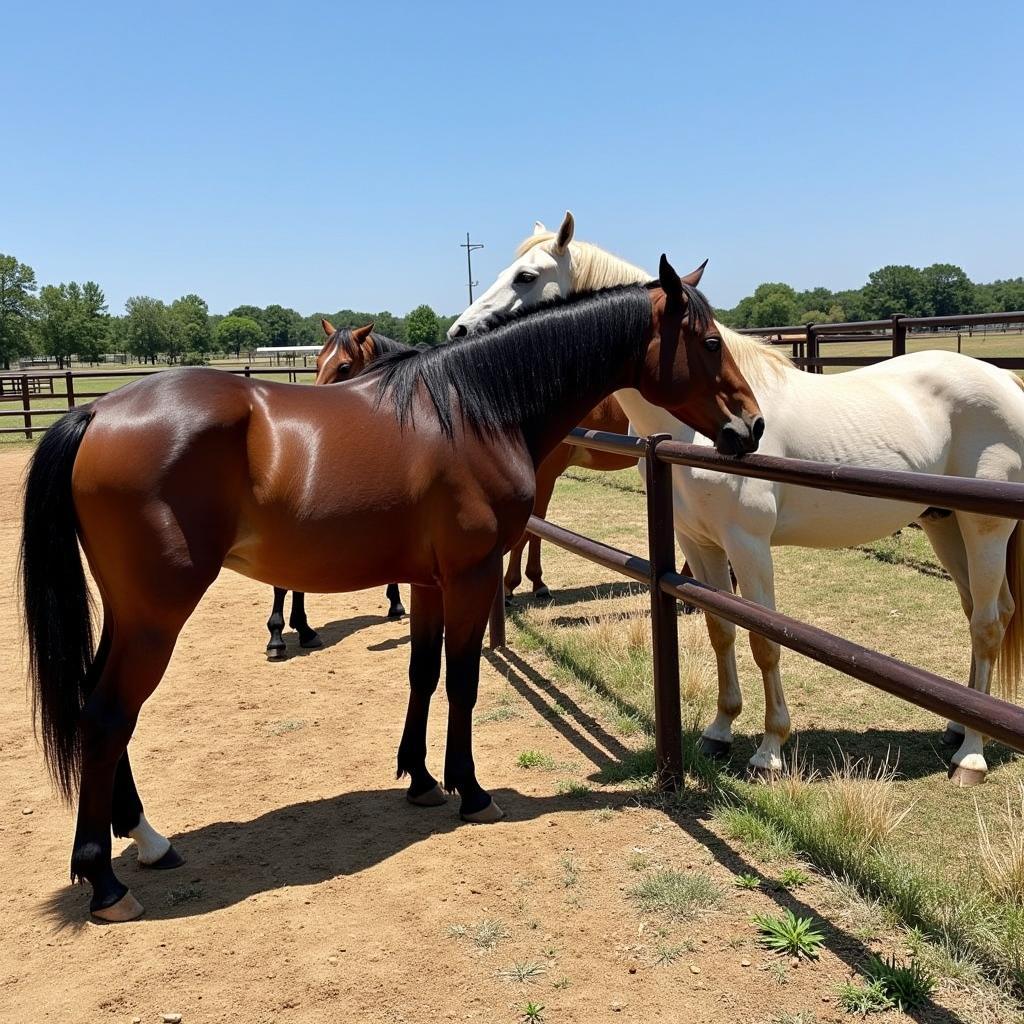Amigo Stock Horse Turnout is crucial for their well-being. Proper turnout allows these athletic horses to exercise, socialize, and enjoy fresh air and sunshine, contributing to their physical and mental health. This guide will delve into the essential aspects of amigo stock horse turnout, offering practical advice and expert insights to ensure your horse thrives.
Understanding the Importance of Turnout for Amigo Stock Horses
Turnout provides numerous benefits for amigo stock horses, mimicking their natural grazing and social behaviors. It helps prevent stiffness, promotes healthy muscle development, and reduces the risk of stable vices that can arise from boredom or confinement. Furthermore, regular turnout allows horses to develop strong hooves and bones, crucial for their long-term soundness.
The Physical Benefits of Turnout
- Improved cardiovascular health
- Enhanced muscle tone and strength
- Stronger bones and hooves
- Reduced risk of colic and other digestive issues
- Prevention of stiffness and lameness
The Mental Benefits of Turnout
- Reduced stress and anxiety
- Increased mental stimulation
- Improved overall mood and well-being
- Opportunity for social interaction with other horses
Planning the Perfect Amigo Stock Horse Turnout
Creating a safe and enriching turnout environment for your amigo stock horse requires careful planning and consideration. Several factors play a vital role in ensuring a positive turnout experience.
Selecting the Right Turnout Space
The ideal turnout area should be spacious enough to allow for free movement and exercise. Fencing should be sturdy and safe, designed specifically for horses. The terrain should be relatively level and free of hazards such as holes, rocks, or debris. Providing access to shelter is essential, protecting your horse from extreme weather conditions.
Determining Turnout Duration and Frequency
The optimal turnout duration and frequency depend on various factors, including the horse’s age, fitness level, and individual needs. Gradually increasing turnout time is crucial, especially for horses unaccustomed to spending extended periods outdoors. Monitoring your horse’s behavior and physical condition is essential to adjust the turnout schedule accordingly.
Introducing New Horses to a Turnout Group
Introducing a new horse to an established turnout group should be done gradually and with caution. Initially, allow the new horse to observe the group from a separate paddock. Then, introduce the horses for short periods under supervision, gradually increasing the duration as they become comfortable with each other.
 Introducing a New Amigo Stock Horse to the Herd
Introducing a New Amigo Stock Horse to the Herd
Managing Amigo Stock Horse Turnout Challenges
While turnout offers numerous benefits, it’s essential to be aware of potential challenges and implement strategies to mitigate them.
Preventing Injuries During Turnout
Regularly inspecting the turnout area for hazards is crucial to prevent injuries. Ensure fencing is secure, and remove any potentially dangerous objects. Providing adequate footing is essential, especially in wet or muddy conditions.
Addressing Behavioral Issues During Turnout
Some horses may exhibit behavioral issues during turnout, such as aggression or excessive running. Understanding the underlying cause of these behaviors is crucial. Consulting with a qualified equine behaviorist can provide valuable insights and guidance.
Managing Turnout for Horses with Special Needs
Horses with specific health conditions may require modified turnout schedules or environments. Working closely with your veterinarian is essential to develop a turnout plan that addresses their individual needs and ensures their safety and well-being.
“Turnout is not just about letting your horse out of the stall; it’s about providing them with an environment that promotes their physical and mental well-being,” says renowned equine veterinarian, Dr. Amelia Shepherd. “A well-planned turnout routine can significantly enhance the quality of life for your amigo stock horse.”
Conclusion
Amigo stock horse turnout is a vital aspect of their overall care. By understanding the benefits, planning strategically, and addressing potential challenges, you can ensure your horse enjoys a safe, enriching, and fulfilling turnout experience. Remember to consult with a qualified veterinarian or equine professional for personalized advice and guidance. Implementing a well-rounded turnout routine will contribute significantly to the health, happiness, and longevity of your amigo stock horse.
FAQ
- How long should I turn my amigo stock horse out for?
- What type of fencing is best for amigo stock horse turnout?
- How can I prevent injuries during turnout?
- What should I do if my horse exhibits behavioral issues during turnout?
- How can I manage turnout for a horse with special needs?
- Is it necessary to provide shelter during turnout?
- How can I introduce a new horse to an existing turnout group?
For further assistance, please contact us at Phone: 0772127271, Email: [email protected] or visit us at QGM2+WX2, Vị Trung, Vị Thuỷ, Hậu Giang, Vietnam. Our customer support team is available 24/7. Explore our website for related articles on horse care and management.